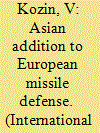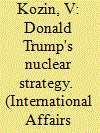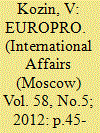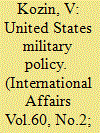|
|
|
Sort Order |
|
|
|
Items / Page
|
|
|
|
|
|
|
| Srl | Item |
| 1 |
ID:
088137


|
|
|
|
|
| Publication |
2009.
|
| Summary/Abstract |
THE GEORGE W. BUSH ADMINISTRATION, which has departed from the political arena, has left new President Barack Obama not only a host of unresolved regional problems, but also an array of issues concerning such a sensitive subject as arms control. The White House has effectively shelved such problem areas as further reduction of strategic offensive weapons (capabilities), tactical nuclear weapons, and control over five key types of conventional weapons in Europe, failing, together with its NATO partners, to ratify the well-known Treaty on Conventional Armed Forces in Europe (CFE).
Now Moscow and Washington will also have to deal with such a sensitive issue as the so called European missile shield - i.e., the deployment of U.S. strategic missile defense systems in Poland and the Czech Republic, planned by the previous Republican administration for deployment by 2011 - if established, they will account for around 25% of the U.S.'s entire strategic missile defense capability.
In this context, special attention also needs to be given to such a problem as the strategic and tactical missile defense system 1 that the United States has widely deployed and constantly upgrades in the Asia Pacific region - a system that has been left, as it were, outside the international debate due to the prominence given to Washington's plans to extend its "missile shield" to eastern Europe, closer to the Russian borders
|
|
|
|
|
|
|
|
|
|
|
|
|
|
|
|
| 2 |
ID:
153463


|
|
|
|
|
| Summary/Abstract |
U.S. PRESIDENT DONALD TRUMP has inherited large strategic and tactical nuclear arsenals from his predecessor, Barack Obama, and a strategy of "unconditional offensive nuclear deterrence," which allows for the possibility of a preemptive nuclear strike against practically any country that is not an ally, friend or partner of the United States.
|
|
|
|
|
|
|
|
|
|
|
|
|
|
|
|
| 3 |
ID:
117383


|
|
|
|
|
| Publication |
2012.
|
| Summary/Abstract |
PRESIDENTS Vladimir Putin and Barack Obama in their joint statement signed on June 18, 2012 at Los Cabos, Mexico, in the margins of the summit of the G20 acknowledged differences in assessments of the missile defense issue in Russian-American relations. For several years, it was a persistent stumbling block to the politico-military agenda of the two mightiest nuclear powers. Still, both parties agreed to "continue a joint search for solutions to challenges in the field of missile defense.
|
|
|
|
|
|
|
|
|
|
|
|
|
|
|
|
| 4 |
ID:
127474


|
|
|
|
|
| Publication |
2013.
|
| Summary/Abstract |
IN THE SECOND HALF of June 2013, the United States announced some adjustments to its nuclear doctrine.
Its main provisions were summarized in the politico-military part of the speech of President Barack Obama at Berlin's Brandenburg Gate on June 191 as well as in the Report on Nuclear Employment Strategy of the United States, prepared by the Pentagon in conjunction with other U.S. departments and agencies, which came out in the same month.2 The individual elements of the "adapted" nuclear strategy were also commented on in a special White House Fact Sheet appearing on the same day.3
|
|
|
|
|
|
|
|
|
|
|
|
|
|
|
|
| 5 |
ID:
130831


|
|
|
|
|
| Publication |
2014.
|
| Summary/Abstract |
During a visit to the Russian federal nuclear centre at Sarov in February 2012, Vladimir, Putin set the task of long term planning in the sphere of armaments, naming the upper limit: for the upcoming 50 years. Speaking as he met with senior commanders from the defence and security ministries and agencies in the Kremlin on November 19, 2013, the President and supreme commander-in-chief of the Russian federations said: we need to fully conceive the nature and prospects of the politico-military processes that are unfolding in the contemporary world and to clearly understand what potential threats may affect the situation around our country.
|
|
|
|
|
|
|
|
|
|
|
|
|
|
|
|
|
|
|
|
|